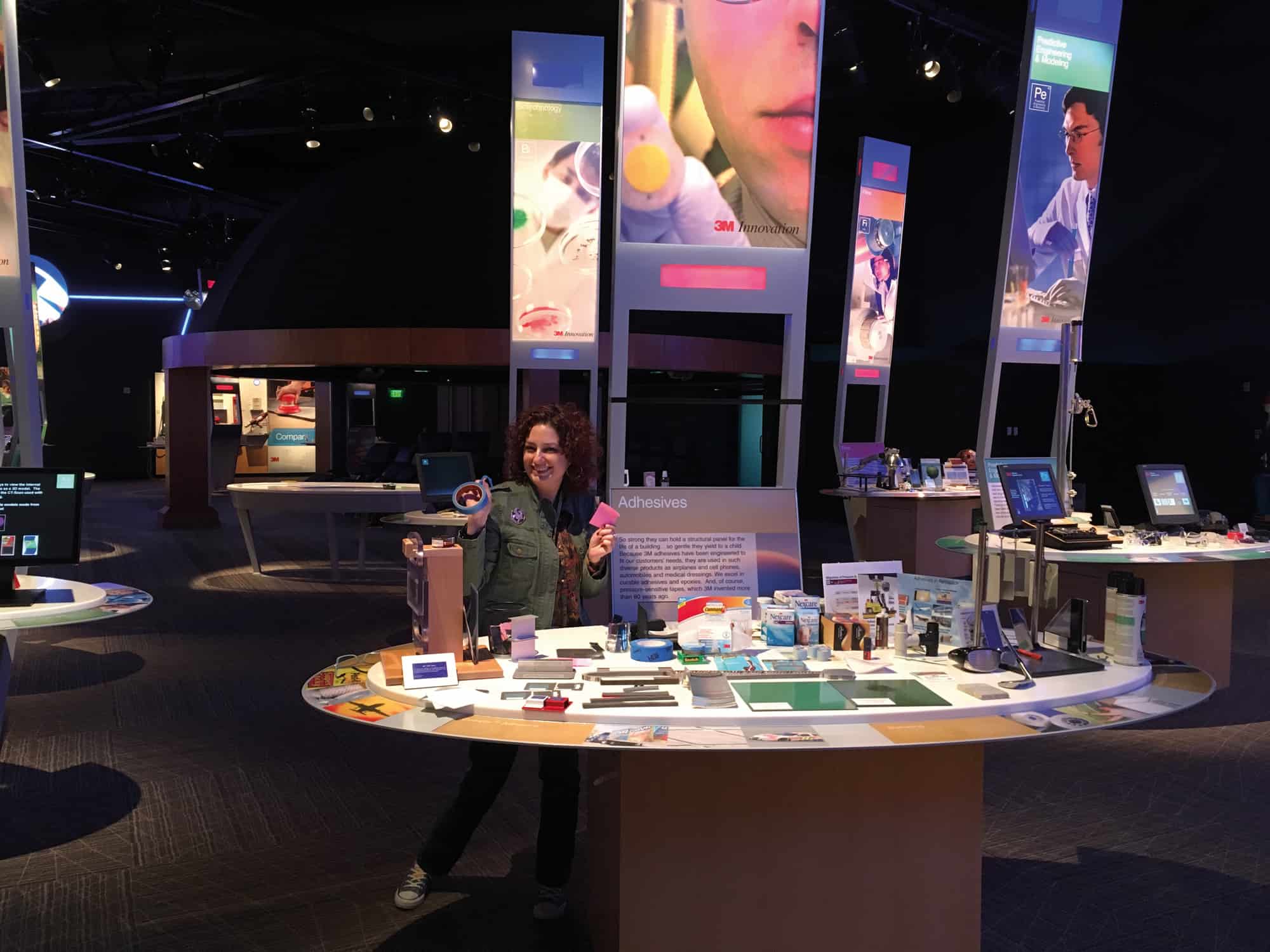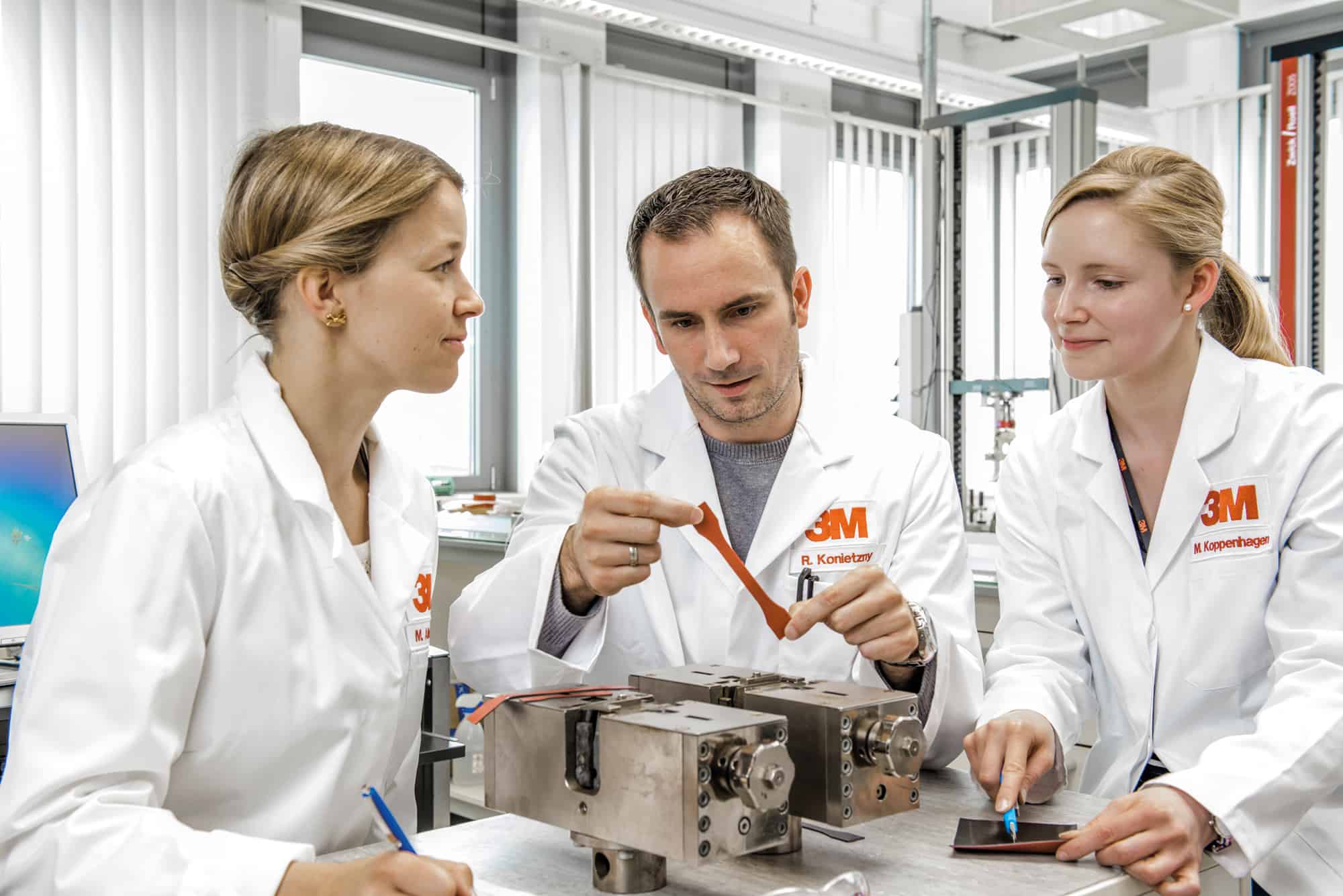Adhesives are everywhere, from the aerospace industry to the simple but infamous Post-it Note. Alaina G Levine visits adhesive-giant 3M Company’s main US innovation centre to find out more about the physics involved

My first thought as I stood in a narrow corridor filled with bright displays, music and booming, cheery announcements was that I had been transported to Walt Disney World, circa 1986. I was, in fact, at the headquarters of a $30bn, multinational materials science and adhesives corporation – 3M Company (3M), the inventors of the Post-it Note. I was here in St Paul, Minnesota, US, to learn about 3M’s contributions to the science and innovation of adhesives and tapes. I had been expecting scientists – not an amusement park for sticky stuff.
The visit began normally enough. In the vast entryway of the 3M Innovation Center, I was greeted by Stefanie Giese-Bogdan, a communications manager with 3M. Inviting me to follow her, she took me down the tunnel-like corridor, before closing the door to leave us standing in silent darkness. Then, the walls, which were covered in huge screens, flashed on to give a sleek multimedia presentation on the history and current work at 3M.
When the intro was over, double doors swung open at the other end of the tunnel. Ahead of me, in a cavernous void, I could just make out a few chairs set up like a planetarium, letting you lean back and gaze at the ceiling. Grinning mischievously, Giese-Bogdan suggested I take the middle chair on the second row for the best view. As I leaned back another presentation began, this time projected on the curved ceiling. And then suddenly, like a true Disney experience, spotlights flipped on all around me.
I was staring at the huge 3M World of Innovation – a massive room at the heart of the 3M Innovation Center, where 3M technologists meet customers to discuss how to incorporate 3M inventions into their products. “Innovation starts with imagination,” says Giese-Bogdan, who has a PhD in analytical chemistry, as we walked around the room’s 27 stations, each devoted to a specific 3M core technology. “At 3M we combine imagination with collaboration and communication. We solve problems by making uncommon connections of technologies and by applying science to life.”
The Industrial Adhesives and Tapes Division at 3M is the largest department in the 116-year-old firm, with more than 6100 employees worldwide, as well as research and development (R&D) centres in 10 countries and manufacturing locations in 26 nations. Adhesives are one of 46 core technologies that 3M puts into its products, but because adhesives are useful in so many sectors – from the aerospace and automotive industries to medical equipment and electronics – they are found in more than 30,000 of the company’s products. And then of course there is the retail and consumer side, with your friendly neighbourhood Post-it Notes and Scotch brand tapes.
The 3M World of Innovation, which is not open to the public, is a showroom and playground. It’s where 3M invites its customers to brainstorm with scientists and discuss how each technology might benefit them. The customers get to play, experiment and discover. They witness demos, learn about new innovations and, together, the 3M specialists and the customers try to solve problems. This is where my tale of tape truly unrolled, as I messed around at an adhesives station and Giese-Bogdan, as one of the hosts of the exhibition, explained to me how the innovation game is played. Like the time the Minnesota Zoo called and explained it had a whale with a wound and needed a special bandage to stick to its slimy lip. In fact, the solution the 3M researchers came up with proved so valuable and flexible that it became incorporated into an entire product line of human bandages.
The science of sticky
To find out more about the science of adhesives, I sat down with Cristina Thomas, senior technical leader in corporate R&D. Thomas has a PhD in chemical engineering but considers herself a polymer physicist because much of her technical career has been in the field of computational materials modelling. “The world around us uses many more adhesives than we realize, because we often need to bond things to surfaces,” she says. Even the room we’re in uses them, as Thomas points to the carpet, ceiling and walls. They are in the room’s electronics, inside the display and even holding the microchips in place. The building is kept energy efficient by film stuck to the windows and stretchable adhesives – 3M Command Strips –hold up the posters. These specialist products can bond to a surface and then once stretched again can be removed without any residue.
An adhesive is a substance capable of holding materials together by surface attachment. Generally made of polymers, modern adhesives allow things to be stuck together without needing to create discontinuities, such as holes, in the substrate materials. They work by creating the same strong molecular forces that hold materials together normally. But as polymer adhesive scientist Anthony Pagliuca from 3M points out on the company’s wesbite, to do so an adhesive must first “wet out” the substrate – it needs to flow over and cover the surface uniformly to maximize the contact area. The extent to which a liquid can wet out depends on surface energy and, for an adhesive to be effective, its surface energy must be equal to or lower than that of the substrate. Adhesion then occurs via interactions such as hydrogen bonding, mechanical interlocking and chemical bonds.
A brief history of 3M

3M was founded in 1902 as a small-scale mining venture under the name Minnesota Mining and Manufacturing Company. But the founders’ original goal, of mining one type of mineral from one mine, turned out to be neither feasible nor sustainable. So they looked at other materials and products and quickly found that they could harness science and engineering to develop and improve products across multiple sectors. Early products from the 1920s included the first waterproof sandpaper and masking tape, which launched the company’s interests in adhesives and tapes. Over the years, 3M has grown into a firm employing 90,000 people, and with 60,000 products used in homes, businesses, schools, hospitals and more, touching most industries on Earth. One-third of 3M’s sales come from products that were invented within the past five years.
One product that 3M is especially well known for is the ubiquitous Post-it Note, which famously was discovered almost by accident. In 1968 Spencer Silver, a 3M scientist, was busily researching adhesives in the laboratory. In the process, he discovered something special: an adhesive that stuck lightly to surfaces but didn’t bond tightly to them. “It was part of my job as a researcher to develop new adhesives, and at that time we wanted to develop bigger, stronger, tougher adhesives,” said Silver. “This was none of those.”
What Silver discovered was something called microspheres, which retain their stickiness but with a “removability characteristic”, allowing attached surfaces to peel apart easily. He started sharing his adhesive with other 3M scientists, trying to discover a problem that the adhesive could solve. Almost six years later Art Fry, another 3M researcher, realized that Silver’s microspheres could serve as an adhesive for a bookmark-type product that can be placed on paper then removed and re-stuck somewhere else. Fry figured out how to manufacture it by 1977, got the green light from management in 1978 and the Post-it Note was officially launched in the US in 1980, and in Europe and Canada in 1981.
The rest is history – Post-it Notes hit the world by storm, and 3M continues to expand the product line, most recently shifting to plant-based adhesives for all its Post-it Notes. Other recent 3M milestones include the company earning its 100,000th patent in 2014, and unveiling a new, state-of-the-art, $150m R&D laboratory on its Minnesota campus in 2015. But Post-it Notes remain one of 3M’s most highly visible product lines and brands.
Adhesion scientists consider three factors when they design their products. First, there is the adhesion mechanism – how the adhesive sticks to and interacts with the various surfaces. Second, the scientists have to identify and examine the forces that will act on the adhesive-containing product while it is being used. These forces, such as shear forces or peel forces, impact the performance of the adhesive and can affect its integrity and function. Finally, there’s the durability, which includes examining how the environment will influence the effectiveness of the adhesive.
Given these factors, it is not surprising to learn that physics plays a huge part in thinking about and designing effective adhesives and tapes. After all, the basic mechanical properties of the adhesives have to be precisely calculated and tested and clarified. Indeed, there is an entire building of labs at 3M dedicated to just this task. It has every piece of equipment you’d expect in a corporate analytics and materials-processing facility.
Managing how polymers flow and understanding their stability during and after application are important aspects of developing both structural and pressure-sensitive adhesives. How will the adhesive be deployed onto a surface? What is the application mechanism? What is the curing mechanism? Some adhesives have to stay sticky while they hold two surfaces together, whereas others become solid or foamy upon curing. Knowing the adhesive’s function and the environment in which it will operate determines how to distribute it on a surface and how strong the chemical bond should be between the adhesive and that surface. Viscosity and elasticity are characteristics of adhesives that matter greatly too. Specialist engineers are needed to design, for example, adhesive storage cartridges and the nozzles from which they are ejected in large-scale industrial systems.
Materials science also plays a role in formulating adhesives and the substrates holding them, like tapes. Depending on the application, adhesives or tapes may need to provide other properties in addition to just good bonding performance. For example, 3M makes a pavement marking tape with a specific optical performance to help motorists. These tapes have a layered structure in which the adhesive is on the side contacting the road while reflective beads are embedded in the top layer so that drivers can see the markings under various environmental conditions. “The adhesive is a mechanism to deliver information to the driver via an additional aspect of physics, which is optics,” notes Thomas.

Moreover, with adhesives and adhesion science embedded in many of 3M’s products, the sticky science is often combined with other technologies. For example, 3M can borrow from one technology, such as its tape formulations, combine it with cross-linking chemistry and create a strong water-based adhesive. For one project, 3M scientists infused viscoelastic foam with adhesives to create strong bonding tape ideal for use in the car industry. They also took ordinary elastomeric materials and developed a proprietary high-strength matrix so manufacturers can create more impact-resistant products. Adhesive experts, meanwhile, dipped into the science of microreplication – one of 3M’s biggest scientific assets. The microreplication process involves melting plastic pellets and squeezing them into rolls of plastic film to create microscopic sculptures on the surface. There can be thousands of features per square centimetre, arranged uniformly, that can change the physical, optical and chemical properties of the surface. One application where 3M scientists have used the technology is to make road signs. Here, the film is typically adhered to aluminium substrates, and thousands of tiny prisms reflect a car’s headlights back to the driver, resulting in signs and markers on roads appearing significantly brighter than normal.
Adhesives also have to withstand a spectrum of environmental stimuli – anything that could impact the function or durability needs to be addressed. Those pavement markings, for example, are exposed to water, oil, atmospheric compounds, such as pollutants, and many other chemicals and concoctions. They have to stay in place and be able to withstand constant shocks, vibrations, and movement from vehicles. Adhesives additionally have to cope with changes in pressure, temperature and a host of other variables.
In one of 3M’s many labs, I met Aaron Hedegaard, a chemical engineer who studies the viscosity and elasticity of different formulations of adhesives to quantify their strength and stickiness. He does this by smearing a sample of an adhesive on a rotational rheometer and measures its stiffness, dissipation factor, and its response to being heated and chilled, even to temperatures well below a typical Minnesota winter. “I develop new test methods, not just running the standard tests,” he says. “I am trying to push the boundaries to make the next standard test.”
3M's SEALS

When designing adhesives for customers, 3M experts ask questions based on the SEALS acronym:
S: Substrate – What is the nature of the substrate?
E: Environment – What is the bonding environment? What environment will the bond be subjected to (internal/external, high/low temperatures, chemicals, salt)?
A: Application –What are you doing with your component? What application characteristics do you need in terms of speed of cure, open time and rheology from the adhesive?
L: Load – What are the stresses on the joint in type, magnitude and direction?
S: Size – For industrial adhesives, how many units are you producing – per month, per quarter or per year?
Overcoming physics
Physics breakthroughs have impacted 3M adhesives in fascinating ways, according to Thomas. To a chemist, a polymer is a macro-molecule composed of repeating smaller molecules or units, but people now understand that these long molecules can be approximated as chains and so their behaviour can be explored and explained using statistical methods from physics.
“We can treat polymers using simplified models where the molecules are represented by individual units or beads that replace the group of atoms,” says Thomas. Macromolecules within the adhesion polymers can then be investigated using physics principles, enabling scientists to understand their behaviour under certain conditions. “If I’m doing a phase separation when it’s a polymeric system, it’s going to behave differently than if I am separating smaller molecules – this is something that really advanced the adhesion science field.”
Depending on temperature, some adhesives behave like glass (solid-like) and some like rubbers (fluid-like), so Thomas and her team draw ideas and knowledge from complex systems too. When you “chemically cure” an adhesive with the aim of converting it into a solid, the adhesive is going through a chemical reaction and, once cured, it is able to provide high strength and resistance to temperature, humidity or chemical exposure. Depending on whether you cure with light, heat or another mechanism, you are enhancing the performance of the adhesive due to the formation of an adhesive network that behaves like a glassy polymer.
But just because there is a lot of physics in adhesives doesn’t mean that 3M scientists are shackled to it. Back in the 3M World of Innovation, Giese-Bogdan showed me the Multi-layer Optical Film – a silvery, reflective piece of film that is used with a special tape. “If you are tilting a reflective surface there is an angle at which it is no longer reflective – that angle is called the Brewster’s angle,” she explains. “The Multi-layer Optical Film does not have a Brewster’s angle, it is reflective at any angle.” The film is used to make light shafts in buildings and, since Brewster’s angle is not a consideration, it can be placed around bends. It can also be used in, for example, electronics – from phones to TVs – to save energy, and as a parabolic mirror to direct light onto solar cells. It is one of the many product examples that Giese-Bogdan has ready to showcase in the World of Innovation. “How often can you say you beat the laws of physics?” she teases. “Well we did. We beat Brewster’s angle.”
The 3M Innovation Center gave me a glimpse into the amazing world of adhesives, and as I left, my take-home message was that adhesives are sticking around and expanding their reach, strength, and diversity of use. “Many of the things that we see every day have adhesives or result from the use of adhesion science. There is a lot of physics, of fundamental understanding behind that,” says Thomas. “Even things we take for granted every day, such as a marking on the road [are bonded by adhesives].” A huge diversity of good adhesives allows lorries to go over those tapes but also allows Post-it Notes to be reused, and allows medical tapes to cover fragile or sensitive skins, as well as countless other applications for tapes and adhesives across the globe.



